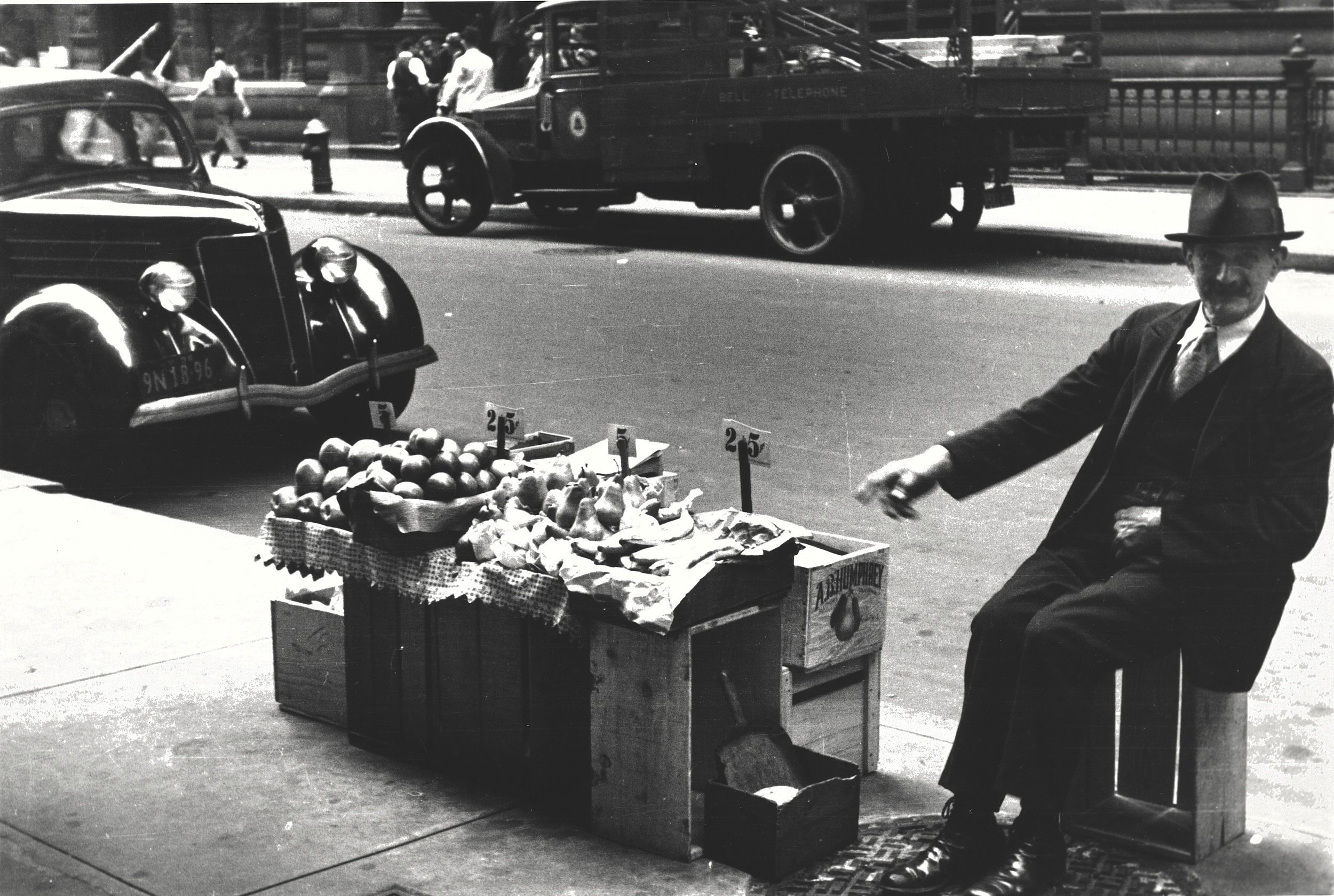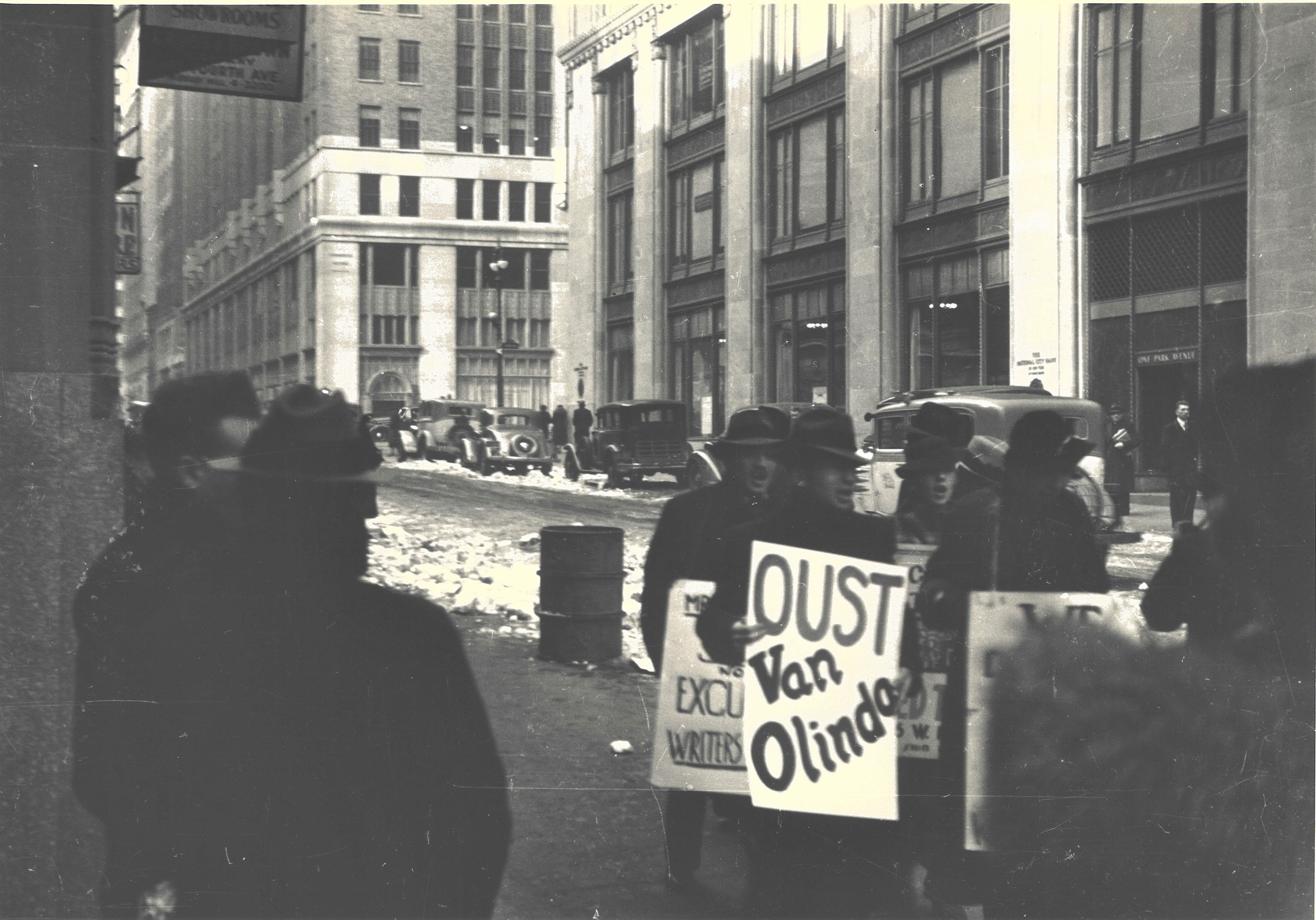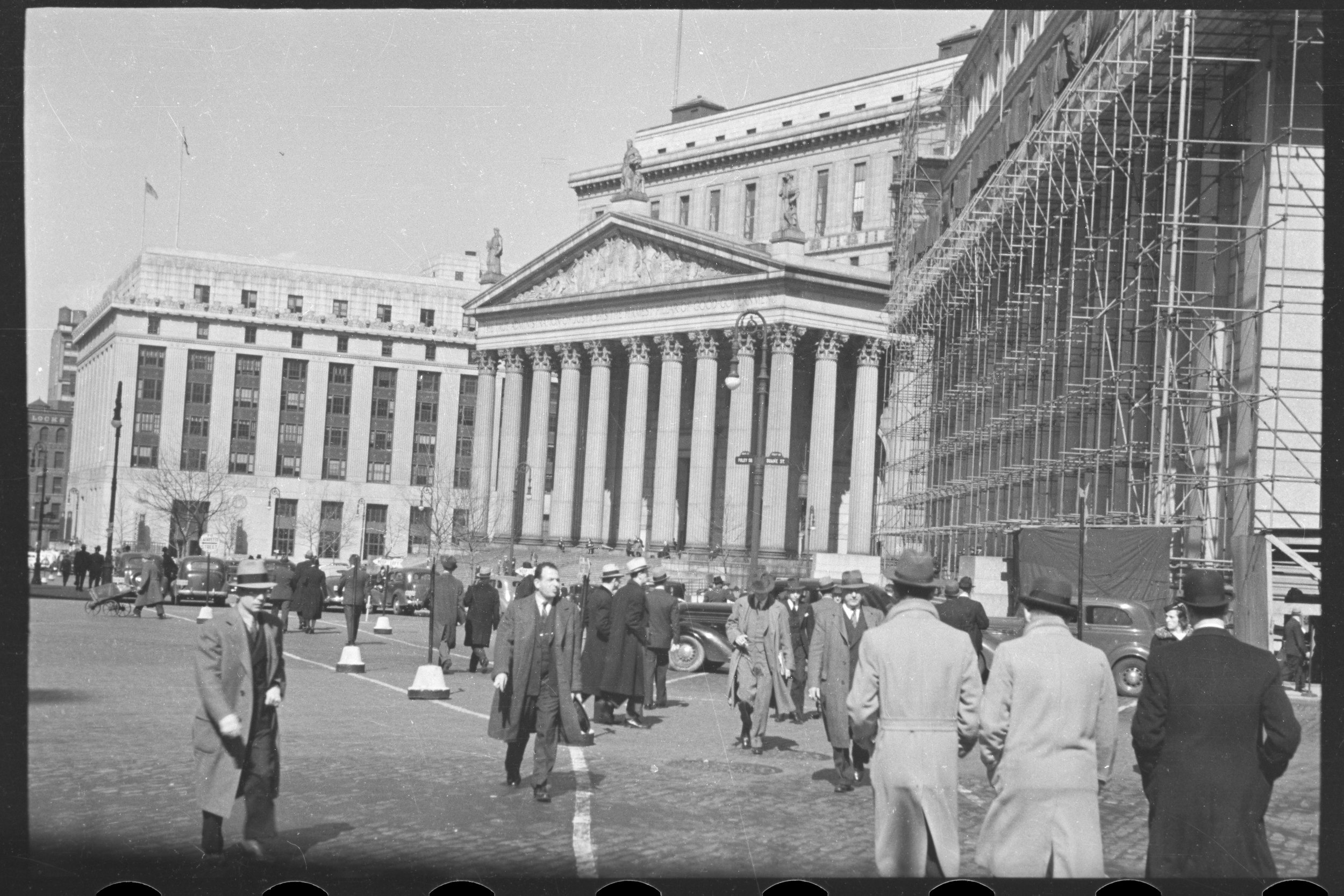Fruit Seller, Manhattan, ca. 1937. Photographer: Clifford Sutcliffe. WPA Federal Writers’ Project Photograph Collection, NYC Municipal Archives.
On September 3, 1980, the Department of Records & Information Services (DORIS) opened its first exhibition as a new agency, “NYC Work and Working: WPA Photographs.” The exhibition was installed in the lobby at 31 Chambers Street. One year previously the executive and administrative offices of DORIS had moved from 23 Park Row into the first floor of the Surrogate’s Court building. The Municipal Archives relocated from Park Row to the Tweed Courthouse pending completion of renovations to the basement level of the building.
The exhibition featured more than 130 images from the Municipal Archives’ WPA Federal Writers’ Project (FWP) photograph collection. Curated by Barbara Head Millstein, the exhibit was funded by a New York State Council for the Humanities grant. Ms. Millstein was a curator at the Brooklyn Museum and a special assistant to Archives’ Director Idilio Gracia-Pena.
To prepare for the exhibit, Ms. Millstein located several surviving photographers from the New York City Unit of the FWP, including Sol Libsohn, Esther Mipass, and David Robbins. She interviewed two photographers, Clifford Sutcliffe and Arnold Eagle, and corresponded with another, Ralph DeSola. Millstein’s interview notes add valuable knowledge about the FWP and the provenance of one of the most appealing and enduring collections in the Municipal Archives.
Waterfront scene, Manhattan, ca. 1937. WPA Federal Writers’ Project Photograph Collection. Photographer: Clifford Sutcliffe. NYC Municipal Archives.
In this week’s blog we are reproducing Ms. Millstein’s notes from the Clifford Sutcliffe interview; a future blog will feature the Arnold Eagle interview and the correspondence with Ralph DeSola.
Clifford Sutcliffe lived at 41 Morton Street, in Greenwich Village. Barbara Millstein and Kenneth Cobb, then an assistant archivist at the Municipal Archives, interviewed him in his home on February 1, 1980. The following are the interview notes.
“Clifford Sutcliffe had no formal training in photography, but from the time he was five years old (he is now 74) he was involved in photography. There were always cameras and darkrooms in his home.
Sutcliffe joined the Federal Writers Project in late December 1935. His job was to rewrite material that reporters brought in for various FWP books. He remembers working on the Almanac for New Yorkers. Another FWP work was a series of books about animals which Ralph De Sola edited.
Feeding Pigeons, Manhattan, ca. 1937. Photographer: Clifford Sutcliffe. WPA Federal Writers’ Project Photograph Collection, NYC Municipal Archives.
Sutcliffe was asked at various times to go out and take a few specific shots which were needed for the books. It seems that he was asked because he was interested in photography and he had a camera. He was the photo editor of the book Who’s Who in the Zoo which De Sola edited.
Accordion player, Manhattan, 1937. Photographer: Clifford Sutcliffe. WPA Federal Writers’ Project Photograph Collection, NYC Municipal Archives.
At some point early on the FWP felt the need to have a formal photographic unit, mostly to help with the finances so that they could purchase film, developer, developer tanks, etc. Bobby Edwards was appointed the Senior Supervisor and given the job of running the unit, although he probably didn’t do any photography. Sutcliffe and another man (he can’t remember who) did the work.
Sutcliffe was paid about $22.00 per week and later was made the Supervisor at $27.00 per week, but he worked fewer hours. For two books, Who’s Who in the Zoo and Reptiles and Amphibians he worked under De Sola and had direction. They visited all the zoos and took many photographs, although in the end they used mostly those photographs they received from the N.Y. Zoological Society. He also did the end papers on these books.
For the most part, though, there was no direction from above. Sutcliffe would roam around the city, but what he would photograph was his decision. The general idea was to “show contemporary life.” One way that he would work would be to take a street like 14th Street. He would start on the west end of 14th St. and take six photographs on each side of each block all the way over to the East River. He did this on several streets, and specifically remembers Washington Square and 19th Street, in addition to 14th Street. His idea was to “try to reproduce the way that the ordinary person in New York City lived.”
Salvation Army sidewalk stand, Manhattan, 1937. Photographer: Clifford Sutcliffe. WPA Federal Writers’ Project Photograph Collection, NYC Municipal Archives.
He also said that “the city is going to change, and a house-to-house view of each street would be valuable.” He was also “interested in showing what it was so that when it became there would be some record of it.” He tried to capture people; he was not interested in pure architectural photography, but he tried “to show the relationship between the architecture and people and city change.”
Sidewalk Santa, Manhattan, 1937. Photographer: Clifford Sutcliffe. WPA Federal Writers’ Project Photograph Collection, NYC Municipal Archives.
He also tried to pick up signs of the times such as the outside of a barbershop with haircut 10¢, etc., and to show what people were wearing. All-in-all, he thinks he took thousands of photographs.
He also did a lot of photography of WPA people at work, especially in the theatre and indoors of WPA white collar personnel. He thinks, though, that 90% of his photographs were outdoors.
There were a maximum of three people taking photographs for the Writers’ Project. He used his own camera and enlarger and they bought the paper, film, developer etc. He did most of his developing and printing [in his] facilities at home. There was no real darkroom at the FWP. There were very ad hoc arrangements for photographers.
He used a Zeiss Contax camera, 1:1,5, 35mm. He still has the camera. He says that in its day this was the best camera, and that in the 1930s very few people used 35mm cameras. Also, at that time the fastest film was 20 ASA. He would generally photograph and develop his film on the same day. He has a great number of “record prints” (4" x 6") in his home.
May Day Demonstration, Union Square Park, 1938. Photographer: Clifford Sutcliffe. WPA Federal Writers’ Project Photograph Collection, NYC Municipal Archives.
WPA Federal Writers’ Project staff on picket-line, Manhattan, 1937. Photographer: Clifford Sutcliffe. WPA Federal Writers’ Project Photograph Collection, NYC Municipal Archives.
He left the Project in about 1937, after the Dies Committee subpoenaed his photos because they wanted to show evidence of Communist Party influence in the FWP. He had taken a good many photographs of people in sit-ins and other demonstrations. [The Dies Committee was a committee of the U.S. House of Representatives, more commonly known as the House Un-American Activities Committee (HUAC).]
Bus interior, 1937. Photographer: Clifford Sutcliffe. WPA Federal Writers’ Project Photograph Collection, NYC Municipal Archives.
Sutcliffe believed that the WPA projects made a great contribution to the cultural life of the United States by conserving artists’ skills and also making those skills available to the public at a price that they could afford. For him personally he improved his skills tremendously, and actually learned a skill. He had been an amateur photographer and in the course of the project he became a professional. He continued to be a professional photographer after he left the Project.
He had one opportunity to exhibit his work in a branch library. They asked for 36 8” x 10” prints but he never learned what happened to those photographs.”
Foley Square, Manhattan, 1937. Photographer: Clifford Sutcliffe. WPA Federal Writers’ Project Photograph Collection, NYC Municipal Archives.
The inventory of the Archives’ FWP photograph collection lists 160 images created by Clifford Sutcliffe. In addition to his pictures for Who’s Who in the Zoo, he photographed a wide range of subjects such as bridges, churches, libraries, and government buildings. The collection also includes photographs documenting the “contemporary life” in NYC that he discussed in his interview. Many of these images can be found in the “People, Local Color, Scenes About Town,” “Street Scenes,” and “Waterfront” categories in the collection. There are also images of his FWP colleagues in their offices and on strike. Only two Sutcliffe pictures are included in the selected images from the WPA FWP photograph collection available in the online gallery.
Clifford V. M. Sutcliffe was born in London, England, on November 8, 1905, and emigrated to the U.S. with his family in 1911. He died in October, 1986.








